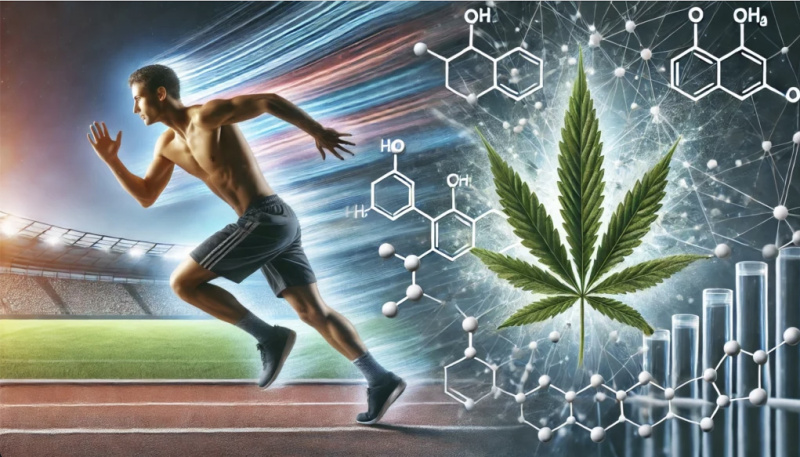Athletes push their bodies to the limit, and injuries are an inevitable part of the game. Concussions have become a major concern in contact sports due to their long-term effects on brain health. The search for better treatments is more urgent than ever. Could cannabis be the unexpected game-changer in sports medicine?
Understanding the Science
The endocannabinoid system (ECS) plays a crucial role in brain function, regulating pain, inflammation, and recovery after injury. It primarily functions through two naturally occurring ligands, 2-arachidonoylglycerol (2-AG) and anandamide (AEA).1 While these endocannabinoids are produced by the body, other compounds such as Δ9-THC from cannabis an also interact with the ECS.
A key feature of the ECS is its retrograde signaling. This means that ligands travel backwards from the postsynaptic neuron to the presynaptic neuron to help regulate neurotransmitter release. The system relies on two main receptors, CB1 and CB2, which both are G protein-coupled receptors (GPCRs).1
- CB1 receptors are found in high concentrations in the brain and help regulate neurotransmitter release, pain perception, and neuroprotection.
- CB2 receptors are primarily located in immune cells and play a role in inflammation and immune response.
When endocannabinoids or other cannabinoids bind to these receptors, they trigger a cascade of intracellular events. For example, CB1 receptor activation can lead to a decrease in cAMP accumulation which can inhibit certain signaling pathways. Another example includes how it can block calcium channels while promoting potassium efflux which will ultimately reduce neurotransmitter release and dampen excessive neural activity. Figure 1 can help give a visual representation of some of effects of the ECS.1

Figure 1. Basic overview of some of the pathways affected through the ECS.
The Ongoing Debate
But the science is still unclear. While early research suggests that cannabinoids may help reduce brain inflammation, protect neurons, and ease concussion symptoms, most findings come from animal studies or small-scale trials.2 There is no concrete evidence that cannabis speeds up brain healing rather than just masking symptoms like pain and headaches.
Sports leagues remain divided on cannabis use. While the UFC and MLB have loosened restrictions, organizations like the NFL and Olympic committees still enforce strict regulations.3 Without true patient centered clinical trials is cannabis a legitimate treatment or just another unproven trend?
Recently, athletes have started to share their personal experiences with cannabis use. Former Seattle Seahawks running back Marshawn Lynch recently appeared on a podcast hosted by Shannon Sharpe, where he shared his experiences and discussed the benefits of cannabis use for NFL players. Here is a link to a small clip from the podcast: Link.
The Path Forward
Researchers are working to bridge the gap between promising early findings and real-world applications. Studies suggest cannabinoids interact with the ECS to reduce inflammation, regulate neurotransmitters, and promote cell survival.1 Some evidence indicates that CBD and THC may help reduce brain swelling, protect neurons, and ease post-concussion symptoms.2
However, more rigorous trials are needed to determine safe and effective dosages and their interactions with existing treatments for traumatic brain injuries (TBI). Sports regulations also raise important questions about how cannabis should be integrated into medical care.
Beyond Sports: A Bigger Conversation
This conversation goes beyond athletes. Millions of people suffer concussions each year, from youth sports to military personnel to everyday accidents. If cannabinoids prove effective, they could revolutionize how we treat brain injuries across all levels of society.
But some critical questions remain: Are we on the verge of a medical breakthrough, or is the hype moving faster than the science?
Final Thoughts
The potential for cannabis in concussion recovery is exciting, but the science isn’t settled yet. While early findings suggest benefits, more research is needed to fully understand the risks and rewards. As discussions on cannabis in sports continue, athletes, doctors, and policymakers must prioritize science over speculation.
References
(1) Kendall, D. A.; Yudowski, G. A. Cannabinoid Receptors in the Central Nervous System: Their Signaling and Roles in Disease. Front Cell Neurosci 2017, 10. https://doi.org/10.3389/fncel.2016.00294.
(2) Hergert, D. C.; Robertson-Benta, C.; Sicard, V.; Schwotzer, D.; Hutchison, K.; Covey, D. P.; Quinn, D. K.; Sadek, J. R.; McDonald, J.; Mayer, A. R. Use of Medical Cannabis to Treat Traumatic Brain Injury. Journal of Neurotrauma. Mary Ann Liebert Inc. July 15, 2021, pp 1904–1917. https://doi.org/10.1089/neu.2020.7148.
(3) Docter, S.; Khan, M.; Gohal, C.; Ravi, B.; Bhandari, M.; Gandhi, R.; Leroux, T. Cannabis Use and Sport: A Systematic Review. Sports Health. SAGE Publications Inc. March 1, 2020, pp 189–199. https://doi.org/10.1177/1941738120901670.
